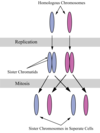Cell Division Flashcards
How many successive nuclear divisions?
Two

How many rounds of DNA Replication?
Only One
- A pair of chromosomes from each parent.
- Similar in length, gene position, and centromere location
Homologous Pairs

One length of DNA which contains genes.
Chromosome
A condensed chromosome joined at the centromere
Chromatid

Two identical chromatids formed by DNA replication
Joined at the Centromere
Sister Chromatids

Region on chromosomes that contains kinetochores
Centromeres

Cylindrical organelles that develop the spindle fibres.
Centrioles

Contains two centrioles
Breaks down to allow centrioles to form spindle fibres
Centrosomes

Slender microtubules to which centromeres attach and are pulled apart.
Spindle Fibers

Cytoplasmic division of a cell
Cytokinesis

Pairing of two homologous chromosomes
Synapsis

A pair of two homologous chromosomes
Tetrad

Structure on the centromere at which sister chromatids join
Kinetochores

What happens in Interphase?

Interesting things happen!
Cell increases in mass
Genetic material doubles
Two centrosomes are produced from a single centrosome
















